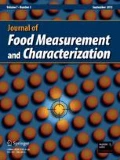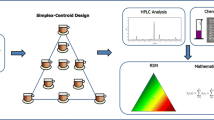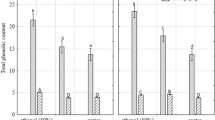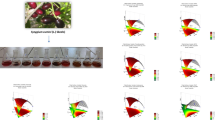Abstract
In this study, the effect of solvent type and solvent concentration on the ultrasound assisted extraction (UAE) of polyphenols from popular tea samples (black, green, mate, blackberry and black mulberry) which have high antioxidant activities were investigated by chemometric approaches. For this purpose, green extraction method was preferred and hydroalcoholic solvents for applied this system in industry. Water, MeOH 100%, MeOH 75%, MeOH 50%, EtOH 100%, EtOH 75%, EtOH 50% were used as extraction solvent. Multivariate calibration analytical technique preferred for quantification of individual phenolic compounds in tea samples and the relationship between total phenolic content (TPC), total flavonoid content (TFC) and total antioxidant activity (TAA) and individual phenolics was determined by chemometric approaches. The results of the study suggest that only spectroscopic comparisons based on TPC, TFC and TAA correlations are insufficient or even incorrect, and this is due to the fact that in tea samples different molecules besides different flavonoid structures are sensitive to spectroscopic techniques. The determination of the appropriate type and the concentration of solvent would contribute the usage of the herbal plants as a source of natural antioxidants in foods and pharmacology in large-scale industrial applications.

Similar content being viewed by others
References
Q.D. Do, A.E. Angkawijaya, P.L. Tran-Nguyen, L.H. Huynh, F.E. Soetaredjo, S. Ismadji, Y. Ju, Effect of extraction solvent on total phenol content, total flavonoid content, and antioxidant activity of Limnophila aromatica. J. Food Drug Anal. 22, 296–302 (2014)
I.K. Bae, H.M. Ham, M.H. Jeong, D.H. Kim, H.J. Kim, Simultaneous determination of 15 phenolic compounds and caffeine in teas and mate using RP-HPLC/UV detection: method development and optimization of extraction process. Food Chem. 172, 469–475 (2015)
J. Dai, R.J. Mumper, Plant phenolics: extraction, analysis and their antioxidant and anticancer properties. Molecules 15, 7313–7352 (2010)
H. Wijngaard, M.B. Hossaın, D.K. Rai, N. Brunton, Techniques to extract bioactive compounds from food by-products of plant origin. Food Res Int 46, 505–513 (2012)
F. Chemat, M. Abert-Vian, A.S. Fabiano-Tixier, J. Strube, L. Uhlenbrock, V. Gunjevic, G. Cravotto, Green extraction of natural products. Origins, current status, and future challenges. Trends Anal. Chem. 118, 248–263 (2019)
R.A. Jacques, L.S. Freitas, V.F. Perez, C. Dariva, A.P. Oliveira, J.V. Oliveira, E.B. Caramao, The use of ultrasound in the extraction of Ilex paraguariensis leaves: a comparison with maceration. Ultrason. Sonochem. 14, 6–12 (2007)
G.J. Gil-Chavez, J.A. Villa, J.F. Ayala-Zavala, J.B. Heredia, D. Sepulveda, E.M. Yahia, G.A. Gonzalez-Aguilar, Technologies for extraction and production of bioactive compounds to be used as nutraceuticals and food ıngredients: an overview. Compr. Rev. Food Sci. F. 12, 5–23 (2013)
D. Pasrija, C. Anandharamakrishnan, Techniques for extraction of green tea polyphenols: a review. Food Bioprocess. Technol. 8, 935–950 (2015)
B. Sultana, F. Anwar, M. Ashraf, Effect of extraction solvent/technique on the antioxidant activity of selected medicinal plant extracts. Molecules 14, 2167–2180 (2009)
K.H. Musa, A. Abdullah, K. Jusoh, V. Subramaniam, Antioxidant activity of pink-flesh guava (Psidium guajava L.): effect of extraction techniques and solvents. Food Anal. Methods 4, 100–107 (2011)
T. Kuzuhara, M. Suganuma, H. Fujiki, Green tea catechin as a chemical chaperone in cancer prevention. Cancer Lett. 261, 12–20 (2008)
Q.M. Wang, Q.Y. Gong, J.J. Yan, J. Zhu, J.J. Tang, M.W. Wang, Z.J. Yang, L.S. Wang, Association between green tea intake and coronary artery disease in a Chinese population. Circ. J. 74, 294–300 (2010)
K. Yoshino, K. Yamazaki, M. Sano, Preventive effects of black tea theaflavins against mouse type IV allergy. J Sci Food Agric 90, 1983–1987 (2010)
B.N. Singh, Prateeksha, A.K.S. Rawat, R.M. Bhagat, B.R. Singh, Black tea: phytochemicals, cancer chemoprevention, and clinical studies. Crit. Rev. Food Sci. Nutr. 57(7), 1394–1410 (2017)
Y. Xu, M. Zhang, T. Wu, S.D. Dai, J. Xu, Z. Zhou, The anti-obesity effect of green tea polysaccharides, polyphenols and caffeine in rats fed with a high-fat diet. Food Funct. 6, 297–304 (2015)
C.-S. Rha, H.W. Jeong, S. Park, S. Lee, Y.S. Jung, D.-O. Kim, Antioxidative, anti-ınflammatory, and anticancer effects of purified flavonol glycosides and aglycones in green tea. Antioxidants 8, 278 (2019). https://doi.org/10.3390/antiox8080278
H. Zhang, R. Qi, Y. Mine, The impact of oolong and black tea polyphenols on human health. Food Bioscience 29, 55–61 (2019)
S. Khokhar, S.G.M. Magnusdottır, Total phenol, catechin, and caffeine contents of teas commonly consumed in the United Kingdom. J. Agric. Food Chem. 50, 565–570 (2002)
A.K. Atoui, A. Mansouri, G. Boskou, P. Kefalas, Tea and herbal infusions: their antioxidant activity and phenolic profile. Food Chem. 89, 27–36 (2005)
B. Astill, M.R. Birch, C. Dacombe, P.G. Humphrey, P.T. Martin, Factors affecting the caffeine and polyphenol contents of black and green tea infusions. J. Agric. Food Chem. 49, 5340–5347 (2001)
B.K. Panda, G. Mishra, A.K. Datta, Orthodox tea (Camellia sinensis L.) oxidation under the influence of compressed air: process optimization. J. Food Process. Preserv. 42:e13573 (2018). https://doi.org/10.1111/jfpp.13573
N.P. Seeram, S.M. Henning, Y. Niu, R. Lee, H.S. Scheuller, D. Heber, Catechin and caffeine content of green tea dietary supplements and correlation with antioxidant capacity. J. Agric. Food Chem. 54, 1599–1603 (2006)
S. Lin, E. Liu, J. Mau, Effect of different brewing methods on antioxidant properties of steaming green tea. LWT Food Sci. Technol. 41, 1616–1623 (2008)
M. Bancirova, Comparison of the antioxidant capacity and the antimicrobial activity of black and green tea. Food Res. Int. 43, 1379–1382 (2010)
A. Serpen, E. Pelvan, C. Alasalvar, B.A. Mogol, H.T. Yavuz, V. Gökmen, N. Özcan, B. Özçelik, Nutritional and functional characteristics of seven grades of black tea produced in Turkey. J. Agric. Food Chem. 60, 7682–7689 (2012)
A.B. Pomilio, S. Trajtemberg, A.A. Vitale, High-performance capillary electrophoresis analysis of mate infusions prepared from stems and leaves of Ilex paraguariensis using automated micellar electrokinetic capillary chromatography. Phytochem. Anal. 13, 235–241 (2002)
C.I. Heck, E.G. Demejıa, Yerba Mate Tea (Ilex Paraguariensis): a comprehensive review on chemistry, health ımplications, and technological considerations. J. Food Sci. 72, 138–151 (2007)
N. Grujic, Z. Lepojevic, B. Srdjenovic, J. Vladic, J. Sudji, Effects of different extraction methods and conditions on the phenolic composition of mate tea extracts. Molecules 17, 2518–2528 (2012)
J. Oszmianski, A. Wojdyło, P. Nowicka, M. Teleszko, T. Cebulak, M. Wolanin, Determination of phenolic compounds and antioxidant activity in leaves from wild Rubus L. species. Molecules 20, 4951–4966 (2015)
A.V. Patel, J. Rojas-Vera, C.G. Dacke, Therapeutic constituents and actions of Rubus species. Curr. Med. Chem. 11, 1501–1512 (2004)
R.G. Melkadze, N.Sh. Chikovani, E.Z. Kakhniashvili, Characteristics of the composition of Caucasian blackberry (Rubus caucasicus L.) leaves as a raw material for tea production. Appl. Biochem. Microbiol. 44, 647–651 (2008)
Ö. Aybastıer, E. Işık, S. Şahin, C. Demir, Optimization of ultrasonic-assisted extraction of antioxidant compounds from blackberry leaves using response surface methodology. Ind. Crops Prod. 44, 558–565 (2013)
A.V. Pavlovic, A. Papetti, D.C.D. Zagorac, U.M. Gasic, D.M. Misic, Z. Lj Tesic, M.M. Natic, Phenolics composition of leaf extracts of raspberry and blackberry cultivars grown in Serbia. Ind. Crops Prod. 87, 304–314 (2016)
S. Srivastava, R. Kapoor, A. Thathola, R.P. Srivastava, Mulberry (Moms alba) leaves as human food: a new dimension of sericulture. Int. J. Food Sci. Nutr. 54, 411–416 (2003)
S.R. Cestic, M.M. Radojkovic, A.D. Cvetanovic, P.Z. Maskovic, S.D. Durovic, Influence of steeping time on biological activity of black mulberry leaves tea. APTEFF 47, 177–191 (2016)
A. El-Mawla, K.M. Mohamed, A.M. Mostafa, Induction of biologically active flavonoids in cell cultures of Morus nigra and testing their hypoglicemic efficacy. Sci. Pharm. 79, 951–961 (2011)
I. Thabti, W. Elfalleh, H. Hannachi, A. Ferchichi, M.D.G. Campos, Identification and quantification of phenolic acids and flavonol glycosides in Tunisian Morus species by HPLC-DAD and HPLC–MS. J. Funct. Foods 4, 367–374 (2012)
A.A. Memon, N. Memon, D.L. Luthria, M.I. Bhanger, A.A. Pitafi, Phenolic acids profiling and antioxidant potential of mulberry (Morus laevigata W., Morus nigra L., Morus alba L.) leaves and fruits grown in Pakistan. Pol. J. Food Nutr. Sci. 60, 25–32 (2010)
M. Bhebhe, T.N. Füller, B. Chipurura, M. Muchuweti, Effect of solvent type on total phenolic content and free radical scavenging activity of black tea and herbal infusions. Food Anal. Methods 9, 1060–1067 (2016)
H. Metrouh-Amir, C.M.M. Duarte, F. Maiza, Solvent effect on total phenolic contents, antioxidant, and antibacterial activities of Matricaria pubescens. Ind. Crop. Prod. 67, 249–256 (2015)
Q.V. Vuong, J.B. Golding, C.E. Stathopoulos, M.H. Nguyen, P.D. Roach, Optimizing conditions for the extraction of catechins from green tea using hot water. J. Sep. Sci. 34, 3099–3106 (2011)
Ö. Algan-Cavuldak, N. Vural, M.A. Akay, R.E. Anlı, Optimization of ultrasound-assisted water extraction conditions for the extraction of phenolic compounds from black mulberry leaves (Morus nigra L.). J Food Process Eng. 42(5), e13132 (2019). https://doi.org/10.1111/jfpe.13132
J. Oh, H. Jo, A.R. Cho, S. Kim, J. Han, Antioxidant and antimicrobial activities of various leafy herbal teas. Food Control 31, 403–409 (2013)
S. Iqbal, U. Younas, Sirajuddin, K.W. Chan, R.A. Sarfraz, M.K. Uddin, Proximate composition and antioxidant potential of leaves from three varieties of Mulberry (Morus sp.): a comparative study. Int. J. Mol. Sci. 13, 6651–6664 (2012)
L. Lee, N. Lee, Y.H. Kim, C. Lee, S.P. Hong, Y. Jeon, Y. Kim, Optimization of ultrasonic extraction of phenolic antioxidants from green tea using response surface methodology. Molecules 18, 13530–13545 (2013)
R.G. Brereton, Multilevel multifactor designs for multivariate calibration. Analyst 122, 1521–1529 (1997)
D.L. Massart, B.G.M. Vandeginste, L.M. Buydens, S. de Jong, P.J. Lewi, J. Smeyers-Verbeke, Handbook of Chemometrics and Qualimetrics, vol. A (Elsevier, London, 1987)
J.S. Boeing, E.O. Barizão, B.C. Silva, P.F. Montanher, V.C. Almeida, J.V. Visentainer, Evaluation of solvent effect on the extraction of phenolic compounds and antioxidant capacities from the berries: application of principal component analysis. Chem. Cent. J. 8, 48 (2014)
N. Turkmen, F. Sari, Y.S. Velioglu, Effects of extraction solvents on concentration and antioxidant activity of black and black mate tea polyphenols determined by ferrous tartrate and Folin-Ciocalteu methods. Food Chem. 99, 835–841 (2006)
Ö.G. Üstündağ, S. Erşan, E. Özcan, G. Özan, N. Kayra, F.Y. Ekinci, Black tea processing waste as a source of antioxidant and antimicrobial phenolic compounds. Eur. Food Res. Technol. 242, 1523–1532 (2016)
N.E. Durling, O.J. Catchpole, J.B. Grey, R.F. Webby, K.A. Mitchell, L.Y. Foo, N.B. Perry, Extraction of phenolics and essential oil from dried sage (Salvia officinalis) using ethanol–water mixtures. Food Chem. 101, 1417–1424 (2007)
M. Alothman, R. Bhat, A.A. Karim, Antioxidant capacity and phenolic content of selected tropical fruits from Malaysia, extracted with different solvents. Food Chem. 115, 785–788 (2009)
J. Yu, M. Ahmedna, I. Goktepe, Effects of processing methods and extraction solvents on concentration and antioxidant activity of peanut skin phenolics. Food Chem. 90, 199–206 (2005)
K. Robards, P.D. Prenzler, G. Tucker, P. Swatsitang, W. Glover, Phenolic compounds and their role in oxidative processes in fruits. Food Chem. 66, 401–436 (1999)
R. Filip, S.B. Lotito, G. Ferraro, C.G. Fraga, Antioxidant activity of Ilex paraguariensis and related species. Nutr. Res. 20, 1437–1446 (2000)
N. Turkmen, Y.S. Velioglu, F. Sari, G. Polat, Effect of extraction conditions on measured total polyphenol contents and antioxidant and antibacterial activities of black tea. Molecules 12, 484–496 (2007)
Y.V. Yuan, D.E. Bone, M.F. Carrington, antioxidant activity of dulse (Palmira palmata) extract evaluated in vitro. Food Chem. 91, 485–494 (2005)
G.A. Akowuah, Z. Ismail, I. Norhayati, A. Sadikun, The effects of different extraction solvents of varying polarities on polyphenols of Orthosiphon stamineus and evaluation of the free radicalscavenging activity. Food Chem. 93, 311–317 (2005)
L.D. Mello, A.A. Alves, D.V. Macedo, L.T. Kubota, Peroxidase-based biosensor as a tool for a fast evaluation of antioxidant capacity of tea. Food Chem. 92, 515–519 (2004)
L. Yu, S. Haley, J. Perret, M. Harris, J. Wilson, M. Qian, free radical scavenging properties of wheat extracts. J. Agric. Food Chem. 50, 1619–1624 (2002)
H. Zielinski, H. Kozłowska, Antioxidant activity and total phenolics in selected cereal grains and their different morphological fractions. J. Agric. Food Chem. 48, 2008–2016 (2000)
M. Bajpai, A. Pande, S.K. Tewari, D. Prakash, Phenolic contents and antioxidant activity of some food and medicinal plants. Int. J. Food Sci. Nutr. 56, 287–291 (2005)
J.M. Lorenzo, P.E.S. Munekata, Phenolic compounds of green tea: health benefits and technological application in food. Asian Pac. J. Trop. Biomed. 6(8), 709–719 (2016)
R. Apak, K. Güçlü, B. Demirata, M. Özyürek, S.E. Çelik, B. Bektaşoğlu, K.I. Berker, D. Özyurt, Comparative evaluation of various total antioxidant capacity assays applied to phenolic compounds with CUPRAC assay. Molecules 12, 1496–1547 (2007)
A.J. Stewart, W. Mullen, A. Crozler, On-line high-performance liquid chromatography analysis of the antioxidant activity of phenolic compounds in green and black tea. Mol. Nutr. Food Res. 49(1), 52–60 (2005)
C.A. Rice-Evans, N.M. Miller, G. Paganda, Structure-antioxidant activity relationships of flavonoids and phenolic acids. Free Radic Biol. Med. 20, 933–956 (1996)
I.C.W. Arts, B. van De Putte, P.C. Hollman, Catechin contents of foods commonly consumed in The Netherlands. 2 Tea, wine, fruit juices, and chocolate milk. J Agric Food Chem 48, 1752–1757 (2000)
L.P. Wright, N.I.K. Mphangwe, H.E. Nyirenda, Z. Apostolides, Analysis of caffeine and flavan-3-ol composition in the fresh leaf of Camellia sinensis for predicting the quality of the black tea produced in Central and Southern Africa. J. Sci. Food Agric. 80, 1823–1830 (2000)
K.L. Bajaj, T. Anan, T. Tsushida, K. Ikegaya, Effects of (−)-picatechin on oxidation of theaflavins by polyphenol oxidase from tea leaves. Agric. Biol. Chem. 51, 1767–1772 (1987)
E. Nishitani, Y.M. Sagesaka, Simultaneous determination of catechins, caffeine and other phenolic compounds in tea using new HPLC method. J. Food Compos. Anal. 17, 675–685 (2004)
T.F.F. Da Silveira, A.D. Meinhart, C.A. Ballus, H.T. Godoy, The effect of the duration of infusion, temperature, and water volume on the rutin content in the preparation of mate tea beverages: an optimization study. Food Res. Int. 60, 241–245 (2014)
T.F.F. Da Silveira, A.D. Meinhart, T.C.L. De Souza, E.C.E. Cunha, M.R. de Moraes, H.T. Godoy, Chlorogenic acids and flavonoid extraction during the preparation of yerba mate based beverages. Food Res. Int. 102, 348–354 (2017)
E.M. Sánchez-Salcedo, P. Mena, C. García-Viguera, F. Hernández, J.J. Martínez, (Poly)phenolic compounds and antioxidant activity of white (Morus alba) and black (Morus nigra) mulberry leaves: their potential for new products rich in phytochemicals. J. Funct. Foods 18, 1039–1046 (2015)
S. Arabshahi-Delouee, D.V. Devi, A. Urooj, Evaluation of antioxidant activity of some plant extracts and their heat, pH and storage stability. Food Chem. 100, 1100–1105 (2007)
A. Djeridane, M. Yousfi, B. Nadjemi, D. Boutassouna, P. Stocker, N. Vidal, Antioxidant activity of some Algerian medicinal plants extracts containing phenolic compounds. Food Chem. 97, 654–660 (2006)
B.S. Bizzoto, A.D. Meinhart, A.C.P. Rybka, M.R. Sobrinho, S.B. Junior, C.A. Ballus, H.T. Godoy, Quantification of phenolic compounds by capillary zone electrophoresis in extracts of four commercial types of mate herb before and after acid hydrolysis. Food Res. Int. 48, 763–768 (2012)
M. A. Rostagno, N. Manchón, M. D’Aarrigo, E. Guillamón, A. Villares, A. García Lafuente, Fast and simultaneous determination of phenolic compounds and caffeine in teas, mate, instant coffee, soft drink and energetic drink by high-performance liquid chromatography using a fused-core column. Anal. Chim. Acta 685, 204–211 (2011)
Author information
Authors and Affiliations
Corresponding author
Ethics declarations
Conflict of interest
No potential conflict of interest was reported by the authors.
Additional information
Publisher's Note
Springer Nature remains neutral with regard to jurisdictional claims in published maps and institutional affiliations.
Rights and permissions
About this article
Cite this article
Vural, N., Algan Cavuldak, Ö., Akay, M.A. et al. Determination of the various extraction solvent effects on polyphenolic profile and antioxidant activities of selected tea samples by chemometric approach. Food Measure 14, 1286–1305 (2020). https://doi.org/10.1007/s11694-020-00376-6
Received:
Accepted:
Published:
Issue Date:
DOI: https://doi.org/10.1007/s11694-020-00376-6




